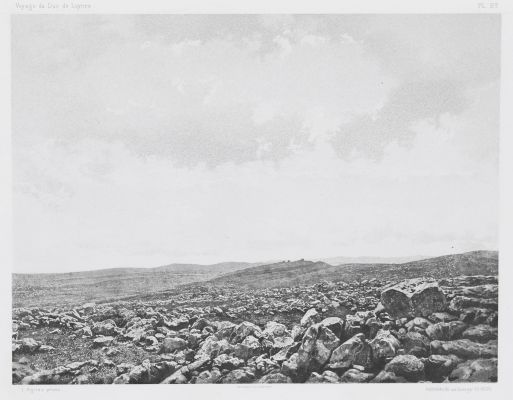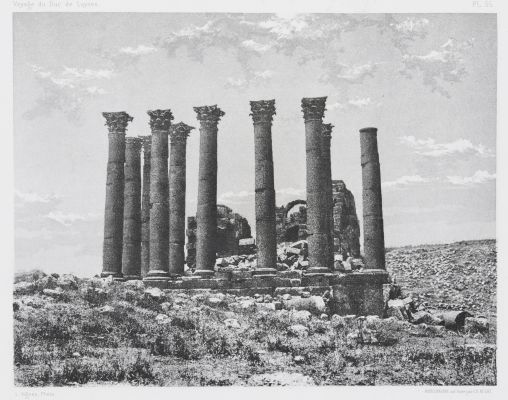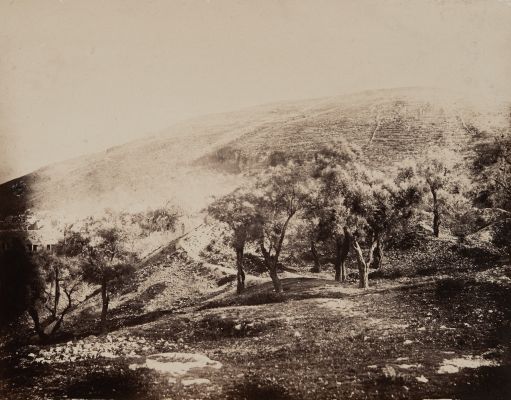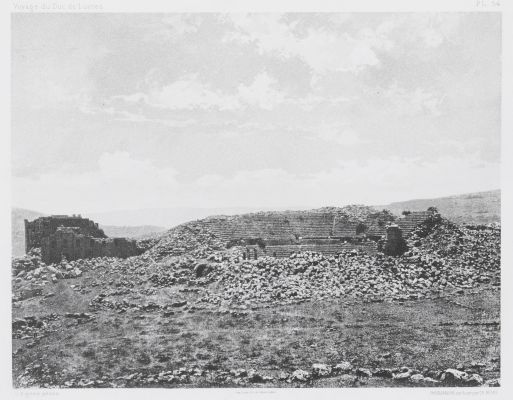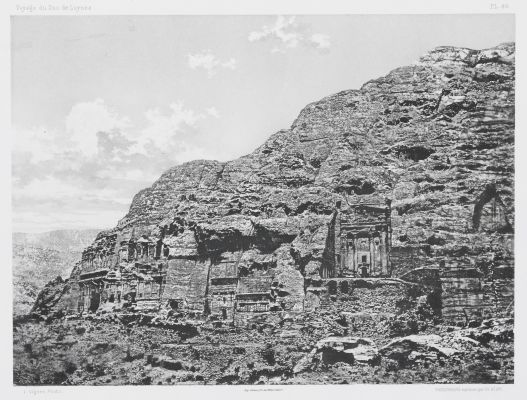
Title
Vue Prise Audessus De Mar SavaArtist
Vignes, Louis (French, 1831-1896)Date
1865-1868 plate (1864 negative)Process
PhotogravureAtelier
Charles NègreImage Size
20.2 x 47 cmSheet Size
50.5 x 72 cm
An incunable of photomechanically-illustrated books and among the earliest published photographs of Jordan and the Dead Sea basin. The Duc de Luynes inherited enormous wealth and spent his life on scientific, archeological and artistic pursuits. Among those was this 1864 private expedition to the Dead Sea basin and interior of Jordan to examine the region’s ancient ruins and perform geological and scientific observations. Luynes was accompanied on the expedition by Lieutenant Louis Vignes, who served as the expedition’s photographer, as well as noted geologist Louis Lartet. Nearly a decade prior to this expedition, in 1856, Luynes had sponsored a contest with the Societe Française de Photographie to discover the best and most practical system of photomechanically reproducing photographs. Among the participants in the contest was Charles Nègre. Although Nègre did not win the 7000 franc prize, Luynes selected him in 1865 to reproduce Vignes’s photographs in this official account of the expedition, paying him 23,250 francs for the commission. Albumen prints made from the original negatives show the original photographs by Vignes, taken no doubt in harsh conditions, were over-exposed. "It is remarkable how Nègre was able to open up the shadows and fill them with light, detail and space [not evident in the original negatives]. But undoubtedly the main reason the Duke chose Nègre to perform this task lay in the quality of the prints Nègre was capable of producing … for he had achieved a control over his process which resulted in prints of rich tones, fine detail, transparency and effect" (Borcoman)
Nègre’s process shares material connections to the region represented, for the central ingredient of Nègre’s process was photosensitive bitumen of Judea, a petroleum product whose main source at the time was the Dead Sea and surrounding areas, a location that Vignes recorded in several panoramic and landscape views. In this context, Nègre’s photogravures overlay dimensions of the material, the historical, and the symbolic, by reproducing sites along one of the largest natural reserves of bitumen, a material used in everything from road construction in ancient times to painting to photography in the modern era. The resulting photogravures were printed from plates made with bitumen, most likely mined from the same area that the printed images represent. In this sense, space and time collapse in the most unlikely of ways, surfacing in photogravures by a man not known to have ever left the borders of France.
One gets a sense of the complex retouching behind Nègre’s productions by comparing Vignes’s photographs, as well as preliminary and intermediate proofs, with the photogravures in their final published state. For instance, a panoramic set of albumen prints made from two negatives of the Judean hills indicates the extent to which Nègre planned out the design of the sky. The pair of albumen photographs were used as a guide for modifying the photogravure plate, evidenced by the fact that the photographs are printed in reverse and thus share the same orientation as that of the printing plate. On the surface of this pair of photographs, Nègre traced the outlines of clouds. Within these outlines, he also jotted down annotations relating to the process of aquatint, including notations as to the relative strength or weakness – “fort” or “faible” – of the acid bath on certain numbered areas in the sky. Nègre also used successive biting to distinguish the darks of the foreground from the lights of the background in the landscape, creating an effect of atmospheric perspective unregistered in the photographic negative. Nègre even invents a thin horizon line at the center of the composition between the mountainous hills. The final double-folio photogravure demonstrates a near seamless integration of the two individual negatives.
Nègre sought not only to correct perceptible defects, and embellish the appearance of skies and seas, but also to make sure the historical information recorded by the camera was framed by a general harmony of effect that neither detracted nor altered the photographic image’s documentary intent. While the amount of work on the print Semoah is exceptional, these graphic interventions wholly changed the reading of Vignes’s work in terms of their photographic beginnings and graphic transformations into an unresolved hybrid aesthetic of reproduction that pervades the entire series. Furthermore, these changes are not just superfluous modifications that accumulate. Rather, they stand as compulsive assertions of authorship introduced to an image. (Lewis)
Reproduced / Exhibited
Parr, Martin, and Gerry Badger. The Photobook: A History. London: Phaidon, 2014. p. 33
References
Lewis JW. Charles Negre in Pursuit of the Photographic. 2012.
Foster, Sheila J. Imagining Paradise: The Richard and Ronay Menschel Library at George Eastman House, Rochester. Rochester, NY: George Eastman House, 2007. Pri



